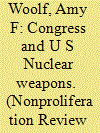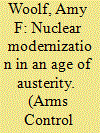|
|
|
Sort Order |
|
|
|
Items / Page
|
|
|
|
|
|
|
| Srl | Item |
| 1 |
ID:
174481


|
|
|
|
|
| Summary/Abstract |
The United States and the Soviet Union, later Russia, have negotiated limits on their nuclear forces for more than 50 years. Arms control has provided both nations with insights into emerging threats from the other’s forces, allowed informed decisions into the types of weapons and capabilities they could eliminate without risking their security, and maintained transparency and communication with an adversary who could kill millions of their citizens in an afternoon.
|
|
|
|
|
|
|
|
|
|
|
|
|
|
|
|
| 2 |
ID:
079627


|
|
|
|
|
| Publication |
2007.
|
| Summary/Abstract |
The U.S. Congress, charged with overseeing U.S. nuclear weapons policy and programs, usually addresses such policies and programs through the annual authorization and appropriations process, focusing mostly on questions of how many and what types of weapons the United States should deploy, with little attention paid to questions about nuclear weapons strategy, doctrine, and policy. The oversight process has brought about some significant changes in the plans for U.S. nuclear weapons, including the elimination of funding for the Robust Nuclear Earth Penetrator study and the shift of that funding into a study of the Reliable Replacement Warhead. But with the focus on authorizations and appropriations, along with the divided jurisdiction over nuclear weapons policy and programs in congressional committees, Congress has not, either recently or during the Cold War and post-Cold War eras, conducted a more comprehensive review of U.S. nuclear weapons strategy, policy, or force structure. Changes in committee jurisdictions could affect the oversight process, but as long as nuclear weapons policy and programs remain a relatively low priority for most members of Congress, and the country at large, it is unlikely that Congress will pursue such a comprehensive debate
|
|
|
|
|
|
|
|
|
|
|
|
|
|
|
|
| 3 |
ID:
110595


|
|
|
|
|
| Publication |
2012.
|
| Summary/Abstract |
In November 2010, as the Senate neared the end of its debate on the New Strategic Arms Reduction Treaty (New START), the Obama administration submitted to Congress an update to its "1251 report," outlining how it planned to maintain and modernize U.S. strategic nuclear forces under the treaty.
|
|
|
|
|
|
|
|
|
|
|
|
|
|
|
|
| 4 |
ID:
129107


|
|
|
|
|
| Publication |
2014.
|
| Summary/Abstract |
When Secretary of Defense Chuck Hagel spoke about U.S. nuclear forces at F.E. Warren Air Force Base in early January, he emphasized two key points. First, he declared that the United States was "going to invest in the modernization we need to invest in to keep that deterrent stronger than it's ever been." He then added that "we're going to continue to require every element of our nuclear deterrent in the triad."[1] His audience at the Wyoming base might have heard a welcome, if unexceptional, commitment to the future of the U.S. nuclear deterrent, but there could have been more to the secretary's comments. In this period of fiscal constraints and declining defense budgets, many in in the wider policy community are voicing doubts about the ability of the United not only to maintain all three legs of the nuclear triad, but also to replace each leg with new missiles, bombers, and submarines. Although the current debate over the future composition of the U.S. nuclear arsenal often is framed in fiscal terms, it is more about the future need for and role of nuclear weapons than it is about how much money the U.S. government is going to spend on them. Critics of the current plans to modernize the U.S. nuclear force structure argue that the investments are excessive because nuclear weapons are less relevant to U.S. national security in the 21st century than they were in the past. Supporters argue that this investment is necessary because nuclear weapons continue to play a critical role in U.S. national security. Regardless, if defense budgets continue to decline in the coming decades, the country may face difficult and possibly illogical trade-offs as it pays for the rising cost of nuclear modernization. The United States deploys strategic nuclear warheads on three types of delivery vehicles: long-range, land-based intercontinental ballistic missiles (ICBMs), long-range submarine-launched ballistic missiles (SLBMs), and long-range heavy bombers based in the United States. Each of the delivery systems in the U.S. nuclear force is aging, and all could reach the end of their service lives in the next 30 years. The warheads that these systems would deliver also are more than 25 years old and contain aging components that may raise questions about their reliability in the future
|
|
|
|
|
|
|
|
|
|
|
|
|
|
|
|
| 5 |
ID:
150319


|
|
|
|
|
| Summary/Abstract |
Analysts seeking to divine the Trump administration’s approach to U.S. nuclear weapons policies have few clues to go on. During the campaign, Donald Trump’s comments were vague and often inconsistent, creating unexpected policy uncertainties as a new president and his national security team take office.
|
|
|
|
|
|
|
|
|
|
|
|
|
|
|
|
|
|
|
|
|